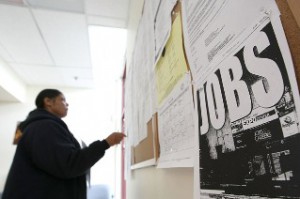
First-time applications for state unemployment benefits rose by 12,000 last week to a seasonally adjusted 472,000, the Labor Department reported Thursday, providing further evidence that U.S. labor markets remain very weak.
The previous week’s initial claims were revised higher by 4,000 to 460,000 as more complete data were collected. Read the full release on the Labor Department’s website.
The jobless claims report shows that the level of layoffs, while down from the peak a year ago, is too high to be consistent with robust job growth. The economy is creating jobs, but too few to bring the unemployment rate down meaningfully.
The four-week average of new claims was roughly unchanged at 463,500. The four-week average is considered a better gauge of labor-market conditions than the volatile weekly number, which can be influenced by non-economic factors such holidays, weather or strikes.
Meanwhile, the total number of people collecting unemployment benefits of any kind fell by 350,000 to 9.47 million in the week ending May 29 from 9.82 million. The number of people collecting federal benefits fell by 170,000 to 5.28 million. These figures are not seasonally adjusted.
The reduction in total claims could be related to the expiration of extended benefits for some recipients. The Senate is wrangling this week with a law that would renew the extended benefits.
The number of people who were collecting state benefits – which are typically available for 26 weeks – rose by 88,000 to 4.57 million in the week ending June 5 after plunging 234,000 the week before.
In a separate report, the Labor Department said the consumer price index fell 0.2% in May, with core prices advancing 0.1%, as expected.
Initial claims are down about 24% compared with the same week a year ago but are unchanged since the first of the year. Continuing claims are down about 29% compared with a year ago and down about 9% since the first of the year.
Jobless claims measure only a portion of the labor market – those who lose jobs through no fault of their own. But they don’t measure the number of people being hired, or the number who quit their jobs voluntarily.
Since the December, hiring and quits have picked up modestly, while layoffs and discharges have fallen to the lowest level in nearly three years, according to other Labor Department data released separately.
The number of people who’ve been out of work for more than six months has surged during this recession to a record 6.8 million in May, accounting for 46% of the 15 million people officially classified as unemployed, according to monthly data previously released.
In response to this long-term unemployment, the federal government has created several new programs of extended benefits. In some states, benefits are available for as much as 99 weeks.
Benefits are generally available for those who lose their full-time job through no fault of their own. Those who exhaust their unemployment benefits are still counted as unemployed if they are actively looking for work.